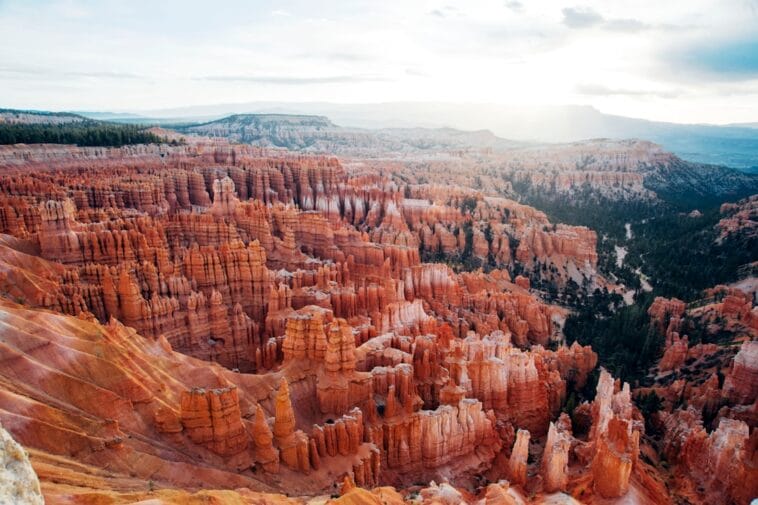The Chihuahuan Desert is North America’s largest desert, encompassing approximately 140,000 square miles. It spans across the Mexican states of Chihuahua, Coahuila, and Sonora, and extends into parts of the southwestern United States, including Texas, New Mexico, and Arizona. This desert is characterized by an arid climate with hot summers and mild winters, receiving an average annual rainfall of 9 inches.
Despite its harsh conditions, the Chihuahuan Desert supports a diverse array of plant and animal species, making it a significant and unique ecosystem. The landscape of the Chihuahuan Desert is distinguished by vast open desert plains, rugged mountains, and deep canyons. The vegetation is primarily composed of shrubs, cacti, and other drought-resistant plants that have evolved to thrive in the arid environment.
The desert ecosystem supports a variety of wildlife, including mammals such as coyotes, bobcats, and mountain lions, as well as reptiles like rattlesnakes and lizards. The distinctive geology and biodiversity of the Chihuahuan Desert make it a compelling subject for scientific study and conservation efforts.
Key Takeaways
- The Chihuahuan Desert is the largest desert in North America, covering parts of the southwestern United States and northern Mexico.
- The unique flora and fauna of the Chihuahuan Desert include species such as the creosote bush, javelina, and roadrunner.
- Compared to other desert ecosystems, the Chihuahuan Desert has a higher diversity of plant and animal species due to its varied topography and climate.
- The Chihuahuan Desert plays a crucial role in conservation and biodiversity, providing habitat for a wide range of endemic species.
- Human impact on the Chihuahuan Desert includes threats from urbanization, agriculture, and climate change, which have led to habitat loss and fragmentation.
- Ecotourism and outdoor activities such as birdwatching and hiking are popular ways to explore the Chihuahuan Desert while promoting conservation efforts.
- Preserving the Chihuahuan Desert ecosystem is important for maintaining biodiversity, protecting endangered species, and ensuring the sustainability of the region.
Unique Flora and Fauna of the Chihuahuan Desert
Plant Life in the Chihuahuan Desert
The desert is home to a diverse range of plant species, including the iconic Sotol, a type of succulent that grows in clumps and has long, narrow leaves. Another common plant in the desert is the creosote bush, which has small, dark green leaves and produces yellow flowers. The desert is also home to a variety of cacti, including the iconic saguaro cactus, as well as prickly pear and barrel cacti.
Animal Life in the Chihuahuan Desert
In addition to its unique plant life, the Chihuahuan Desert is also home to a diverse range of animal species. One of the most well-known animals of the desert is the roadrunner, a fast-running bird that is known for its distinctive appearance and behavior. The desert is also home to a variety of reptiles, including several species of rattlesnakes, as well as lizards and turtles.
Other Desert Dwellers
Mammals such as coyotes, bobcats, and javelinas are also common in the Chihuahuan Desert. The desert’s unique flora and fauna make it a fascinating ecosystem to explore and study.
Comparing the Chihuahuan Desert to Other Desert Ecosystems

The Chihuahuan Desert is often compared to other desert ecosystems around the world, such as the Sonoran Desert in Arizona and the Atacama Desert in South America. While all deserts share some common characteristics, such as arid climates and limited rainfall, each desert ecosystem has its own unique features and biodiversity. The Chihuahuan Desert is known for its rugged mountains and deep canyons, which set it apart from other deserts.
It also has a unique mix of plant and animal species that are not found in other desert ecosystems. One of the key differences between the Chihuahuan Desert and other deserts is its climate. The Chihuahuan Desert experiences hot summers and mild winters, while other deserts may have different temperature patterns.
Additionally, the Chihuahuan Desert receives an average of 9 inches of rainfall per year, which is higher than some other deserts but lower than others. These differences in climate and geography contribute to the unique characteristics of the Chihuahuan Desert and make it an important ecosystem to study and conserve.
The Chihuahuan Desert’s Role in Conservation and Biodiversity
| Metrics | Data |
|---|---|
| Species Diversity | Over 3,500 plant species and 1,000 vertebrate species |
| Endemic Species | Over 600 species are found only in the Chihuahuan Desert |
| Conservation Areas | Over 100 protected areas covering 3% of the desert’s area |
| Threatened Species | Over 100 species are considered threatened or endangered |
The Chihuahuan Desert plays a crucial role in conservation and biodiversity due to its unique flora and fauna. The desert is home to a number of endemic species that are found nowhere else in the world, making it an important area for conservation efforts. In recent years, there has been a growing recognition of the need to protect the biodiversity of the Chihuahuan Desert and preserve its unique ecosystems.
Conservation efforts in the Chihuahuan Desert focus on protecting endangered species, preserving natural habitats, and promoting sustainable land use practices. One of the key conservation challenges facing the desert is habitat loss due to urban development, agriculture, and mining activities. Efforts are underway to establish protected areas and wildlife corridors to ensure the long-term survival of the desert’s plant and animal species.
Additionally, conservation organizations are working with local communities to promote sustainable practices that minimize the impact on the desert’s fragile ecosystems.
Human Impact on the Chihuahuan Desert
Human activities have had a significant impact on the Chihuahuan Desert ecosystem. Urban development, agriculture, mining, and recreational activities have all contributed to habitat loss and degradation in the desert. As human populations continue to grow in the region, there is an increasing need to balance economic development with conservation efforts to protect the desert’s unique biodiversity.
One of the key challenges facing the Chihuahuan Desert is water scarcity. The limited rainfall in the desert makes water a precious resource, and human activities such as agriculture and urban development can put additional strain on water supplies. Efforts are underway to promote water conservation and sustainable water management practices to ensure that the needs of both humans and wildlife are met.
Another significant impact on the Chihuahuan Desert is climate change. Rising temperatures and changing precipitation patterns can have profound effects on the desert’s ecosystems, including shifts in plant and animal distributions and increased risk of wildfires. Efforts to mitigate climate change through reducing greenhouse gas emissions and promoting renewable energy sources are crucial for protecting the long-term health of the Chihuahuan Desert.
Exploring the Chihuahuan Desert: Ecotourism and Outdoor Activities

Exploring Big Bend National Park
One popular destination for ecotourism in the Chihuahuan Desert is Big Bend National Park in Texas. The park offers a variety of outdoor activities, including hiking, camping, birdwatching, and river rafting along the Rio Grande. Visitors can also explore the park’s diverse ecosystems, from desert landscapes to mountain forests, and learn about the region’s rich cultural history.
Conservation Efforts through Ecotourism
In addition to national parks, there are also opportunities for ecotourism in other parts of the Chihuahuan Desert, such as nature reserves and wildlife refuges. These areas provide opportunities for visitors to experience the desert’s natural beauty while supporting conservation efforts through sustainable tourism practices.
Discovering the Desert’s Natural Beauty
The Chihuahuan Desert’s unique landscapes and ecosystems offer endless opportunities for exploration and discovery. From hiking and camping to birdwatching and stargazing, visitors can experience the desert’s natural beauty up close while supporting responsible tourism practices.
The Importance of Preserving the Chihuahuan Desert Ecosystem
Preserving the Chihuahuan Desert ecosystem is crucial for maintaining biodiversity and ensuring the long-term health of the region’s natural resources. The desert provides important habitat for a wide range of plant and animal species, many of which are found nowhere else in the world. Protecting these species helps maintain healthy ecosystems and supports important ecological processes such as pollination, seed dispersal, and nutrient cycling.
In addition to its ecological value, the Chihuahuan Desert also holds cultural significance for indigenous communities who have lived in the region for thousands of years. Preserving the desert’s natural landscapes helps protect traditional knowledge and cultural practices that are tied to the land. Conserving the Chihuahuan Desert also has economic benefits for local communities through ecotourism and sustainable land use practices.
By protecting natural habitats and promoting responsible tourism, conservation efforts can help support local economies while preserving the desert’s unique biodiversity for future generations. In conclusion, the Chihuahuan Desert is a unique and important ecosystem that provides valuable ecological, cultural, and economic benefits. Protecting this diverse desert landscape requires collaborative efforts from governments, conservation organizations, local communities, and visitors alike.
By working together to promote sustainable land use practices, conserve natural habitats, and support responsible tourism, we can ensure that the Chihuahuan Desert continues to thrive for generations to come.
If you’re interested in exploring the diverse landscapes of Africa, you may want to check out this article on Liwonde National Park. This park is home to a wide variety of wildlife and offers visitors the chance to experience the beauty of the African wilderness. Whether you’re interested in birdwatching, game drives, or simply taking in the stunning scenery, Liwonde National Park has something for everyone. (source)


